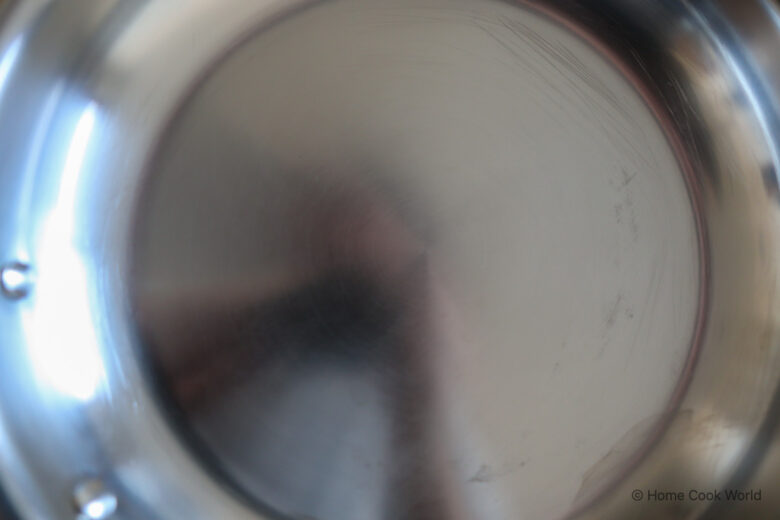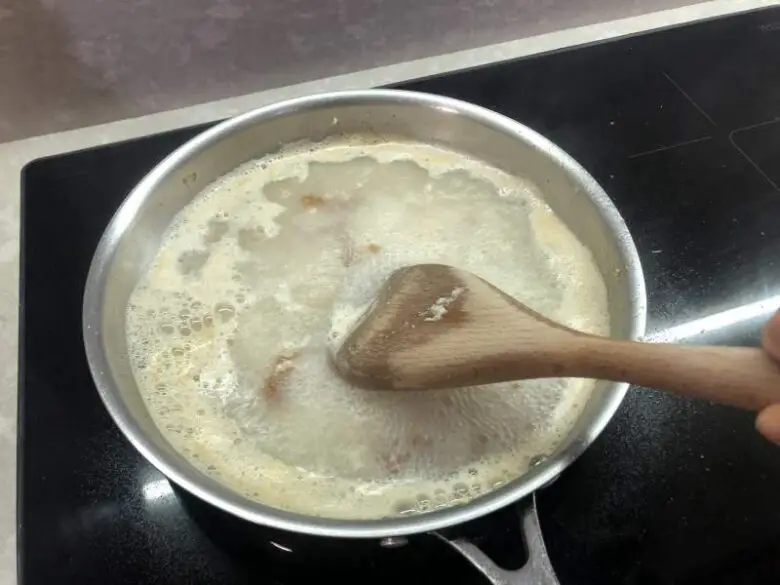I made cacio e pepe the other day and it turned out wonderful. (If you don’t know my cacio e pepe recipe yet, you should definitely try it out.)
However, I used a little too high of a heat than I should have, and some of the cheese from the sauce stuck to the bottom and sides of my stainless steel pan.
Normally, I would clean the pan with a strong cleaning powder for this purpose (I’ll tell you all about it in a few minutes). I sprinkle a generous amount of powder on the pan, pour in lukewarm tap water, and start scrubbing the food residue off the surface with a scrub sponge.
This time I was lazy and in a hurry to use the pan to sauté a bunch of asparagus as a side. Well, most of you probably know where this story is going… I decided to be “practical” about cleaning up the pan, and thought it would be a good idea to carefully scrape off the cheese with a spoon.
Guess what?
I ended up scratching the cooking surface.

If you are in a similar situation right now, I wrote this post for you. My goal is to help you figure out why scratches occur, what you can do to prevent them, and weigh in—with a layman’s opinion—on whether your pan is still safe to use.
What causes scratches on stainless steel frying pans? And how can you prevent them from happening?
You can scratch a stainless steel frying pan or pot by stirring food with a metal fork or spatula in it, as well as by cleaning it with a scrub pad or steel wool. Prevent scratches on stainless steel by cooking with silicone or wooden utensils and using cleaning powder like Bar Keepers Friend.
This is what makes cooking with stainless steel trickier than with, say, ceramic or non-stick.
Some say this isn’t a bug, but a feature. Food sticks to stainless steel, especially if it’s rich in protein and low in fat. But that brown residue that forms on the bottom of the pan doesn’t have to go down the drain.
Add beer, broth, or wine to the empty pan, throw in a few garlic cloves, herbs, and spices, then bring the whole thing to a simmer and cook until reduced. The result will be the most delicious pan sauce for pouring over your steak, chops, or fillets—the same kind they’d serve at a steakhouse or upscale restaurant.
(Psst! Chefs call this technique “deglazing,” and it’s worth adding to your arsenal.)
If you’re not in the mood for turning that baked-on residue into food sauce, cleaning it up can be quite the challenge. When food sticks, the protein forms pretty tight bonds with the metal. While the food eventually releases itself, the baked-on bits and pieces left behind take a lot of elbow grease to scrape off.
The best way to remove it is to fill the pan with water and wait 20-30 minutes before giving it a good soap down with dish soap, warm water, and a soft sponge. If you’re in a hurry, use the all-mighty cleaning powder Barkeepers Friend.
But, by all means, don’t do as I did and try to “gently remove” the residue with a metal or wooden utensil from a dry pan. It’s almost guaranteed that you will scratch your pan.
Is Scratched Stainless Steel Cookware Safe?
If you scratched your stainless steel pan or pot in one way or another, should you be worried?
All stainless steel cookware is made out of food-grade stainless steel. It’s considered safe for food contact by the US Food & Drug Administration (FDA), the American National Standards Institute (ANSI), as well as the US National Science Foundation (NSF).
Food-grade stainless steel is an iron alloy that consists of at least 16% chromium and 8% nickel. The chromium and nickel content is what protects the steel from corrosion and rust from its exposure to the oxygen in the air and the acidic liquids in your food.
According to a 2013 study published in the Journal of Agricultural and Food Chemistry found, stainless steel leaches some of its chromium and nickel content into your food, even when it’s brand new. The more acidic the food and the longer the cooking time, the study concluded, the bigger the leached amount of chromium and nickel.
In general, stainless steel pans and pots scratched lightly from day-to-day use are as safe to cook in as brand new ones. However, deep scratches that expose the aluminum core of clad stainless steel pans can make them unsafe to use.
Stainless steel is a poor conductor of heat. A frying pan made out of stainless steel alone would heat slowly and unevenly, taking forever to preheat and under/overcooking your food with its many cold and hot spots.
For good cookware, stainless steel needs a core made of another, more conductive metal. This metal is usually aluminum or, in the case of higher-end pans and pots, copper. The stainless steel body gives the cookware durability and makes it dishwasher-safe; the aluminum or copper core heats up quickly and evenly.
Cookware manufacturers have two ways to achieve this.
On cheaper cookware, they make the pan out of stainless steel and attach an aluminum or copper base to the underside on the bottom. This type of pans are known as “disc-bottomed” pans.
On higher-end cookware, they make a cooking vessel out of three or more layers of stainless steel, aluminum, and/or copper pressed together in the form of a pan. This type of pans are known as “clad” or “fully clad” pans.
Clad pans are considered to be superior to disc-bottomed pans because the aluminum or copper core runs all the way to the sides. This allows for more even heating and gives you, the cook, more precise control over the cooking temperature.
Many stainless steel cookware owners are worried that, by scratching the pan, they can expose the aluminum or copper base underneath.
Come to think of it, that’s a legitimate concern: aluminum and copper are reactive metals. When they come into contact with the acidity in your food, they will react with it and leach.
But here’s the thing… these pans are made out of hefty sheets of stainless steel, usually 2-3 millimeters in thickness. You’d have to put in a lot of elbow grease, maybe even use a drill, to penetrate the stainless steel exterior enough to expose the aluminum or copper core.
How to Clean Stainless Steel Cookware Without Scratching It
Nine times out of then, I use Barkeepers Friend to get rid of stubborn food residue stuck and baked to the bottom and sides of my pan. Add some powder, pour some water to liquify it, and scrub away with a soft sponge or a scouring pad.
For those of you who’d like to avoid heavy-duty cleaners, there’s an alternative—and just as effective—cleaning method.
Fill your pan with enough water to submerge the burn line. Bring to a boil over high heat and, with the help of a wooden spatula, get those bits and pieces of food unstuck from the cooking surface. Let cool, then wash by hand in the sink with soapy water.

Optionally, I add apple cider vinegar or Bar Keepers Friend for persistent stains or baked-on oil, letting it boil for the same amount of time before scraping off the food residue. I’ve described this method in more detail in my post, “How to Clean Eggs Off a Stainless Steel Pan (With Pictures)”.
In Conclusion
Scratches on stainless steel cookware are normal. If you use your pans and pots every day, which most people do, they happen. As long as the scratch isn’t so deep that it exposes the aluminum core, which is extremely difficult, you can generally use a scratched pan or pot without hesitation.
To avoid scratches on your stainless steel cookware (or to at least keep them to a minimum), use silicone or wooden utensils to stir food and clean it with cleaning powder instead of abrasive cleaners whenever you have the chance.
Editor’s note: We updated this post on January 18, 2022, with reader feedback. An earlier version of the post incorrectly identified aluminum as a magnetic, and therefore induction-friendly, metal. As usual, we thank our readers for helping us keep our posts factually accurate and useful for every home cook on the Internet!

